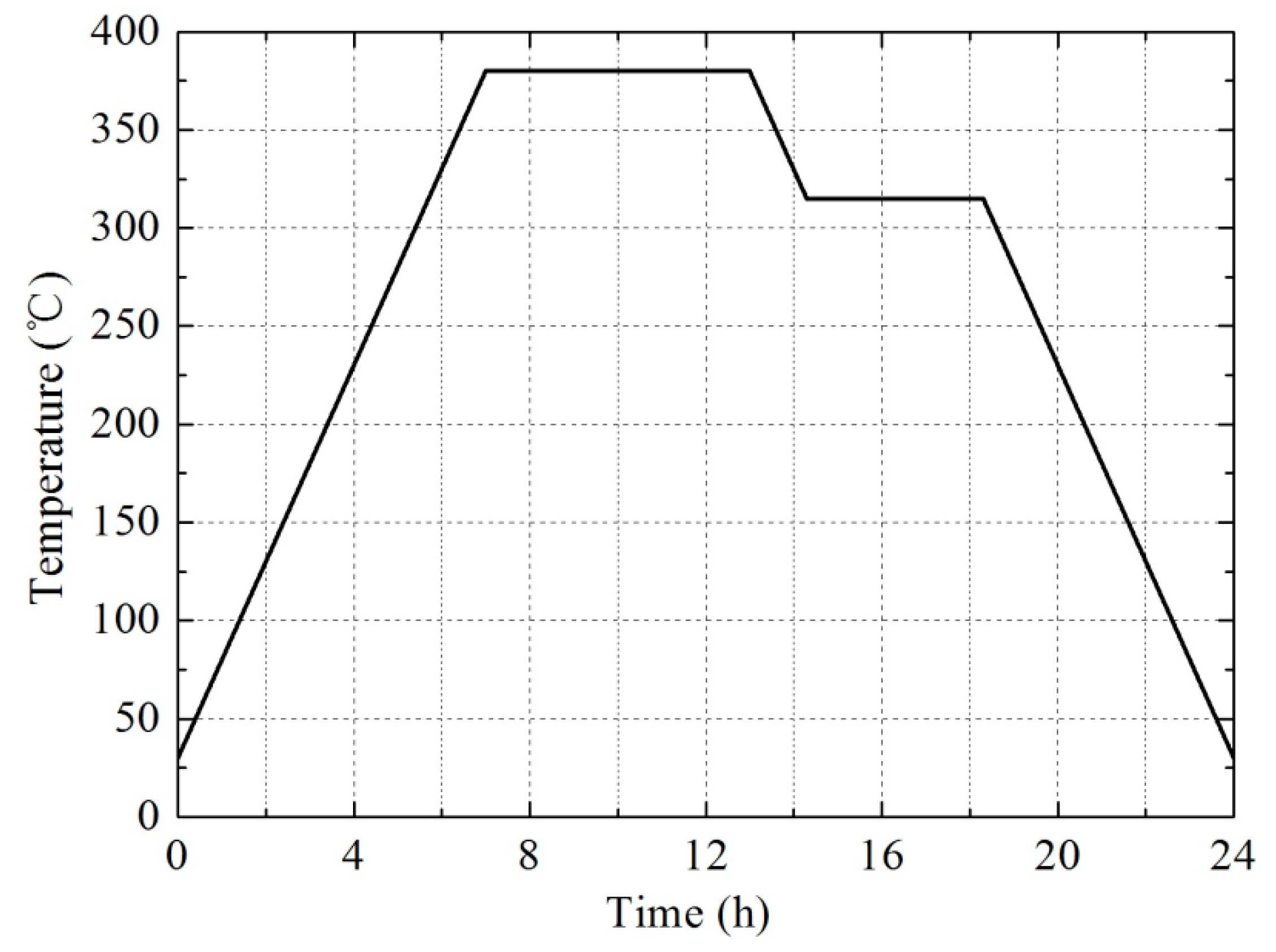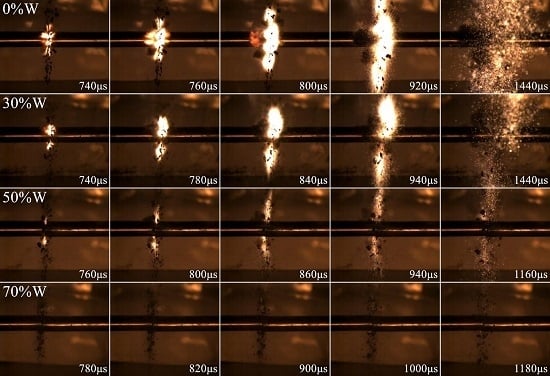Experimental Study on Impact-Induced Reaction Characteristics of PTFE/Ti Composites Enhanced by W Particles
Abstract
:1. Introduction
2. Experimental Materials
2.1. Preparation of Experimental Samples
- (1)
- First, the PTFE, Ti, and W powders were mixed with a small amount of absolute alcohol as a medium for 10 h by a planetary mill machine. Then the powders were dried at 57.2 °C in a vacuum drying oven for approximately 24 h.
- (2)
- The dried powder mixtures were pressed at 200 MPa for about 3 min through cold uniaxial pressing, and the cylindrical billets were prepared.
- (3)
- The pressed billets were relaxed at ambient pressure and temperature for 24 h to remove any trapped air or residual stress, and then they were sintered in an argon atmosphere at 380 °C. Figure 1 shows the temperature steps of the sintering cycle, which can be described as follows: The oven temperature was raised up to 380 °C at a rate of about 50 °C/h. The billets were held at 380 °C for 6 h, then the temperature was reduced at a rate of about 50 °C/h to 315 °C and maintained for 4 h. The billets were then cooled to ambient temperature at an average cooling rate of 50 °C/h.
- (4)
- Finally, the sintered billets were processed into cylindrical experimental samples by a milling machine with a final size of φ 8 × 5 mm2.
2.2. Microstructure of Composites
2.3. Reaction Mechanism Analysis
3. SHPB Experiments
4. Results and Discussion
4.1. Dynamic Compression Properties
4.2. Impact-Induced Reaction Characteristics
5. Conclusions
- (1)
- PTFE/Ti/W composites undergo exothermic reactions at 510 °C to 600 °C, which overlaps the temperature range of PTFE decomposition. The major reaction product is TiFx, and little W undergoes any chemical change. The reaction heat is significantly reduced with increasing W content.
- (2)
- PTFE/Ti/W composites exhibit obvious strain hardening effect and strain rate effect under dynamic compression. Mechanical strength is improved as W content increases, whereas the failure strain is reduced. The PTFE/Ti/W composites tend to become more brittle with the increasing W content. The major failure mechanisms of the composites are the fracture of the PTFE matrix and the separation of metal particles from the matrix.
- (3)
- The impact-induced reaction of PTFE/Ti/W composites occurs at some time after the material failure. Increasing the strain rate significantly improves the reaction degree. As W content increases, the reaction degree is greatly reduced. The ignition delay time becomes longer, while the reaction duration becomes shorter. Both the strain rate and the specific energy thresholds for impact ignition are improved. PTFE/Ti/W composites tend to become more inert with increasing W content.
Acknowledgments
Author Contributions
Conflicts of Interest
References
- Koch, E.C. Metal-Fluorocarbon Based Energetic Materials; Wiley-VCH Verlag Gmbh & Co. KGa A: Weinheim, Germany, 2012; pp. 6–17. [Google Scholar]
- Zhang, X.F.; Zhao, X.N. Review on Multifunctional Energetic Structural Materials. Chin. J. Energ. Mater. 2009, 17, 731–739. [Google Scholar]
- Committee on Advanced Energetic Materials and Manufacturing Technologies, National Research Council. Advanced Energetic Materials; National Academies Press: Washington, DC, USA, 2004; pp. 1–23. [Google Scholar]
- Lee, R.J.; Mock, W., Jr.; Carney, J.R.; Holt, W.H.; Pangilinan, G.I.; Gamache, R.M.; Boteler, J.M.; Bohl, D.G.; Drotar, J.; Lawrence, G.W. Reactive Materials Studies. Shock Compression Condens. Matter 2005, 845, 169–174. [Google Scholar]
- McGregor, N.M.; Sutherland, G.T. Plate Impact Experiments on a Porous Teflon-Aluminum Mixture. Shock Compression Condens. Matter 2003, 706, 1001–1004. [Google Scholar]
- Ames, R.G. Energy Release Characteristics of Impact-Initiated Energetic Materials; Materials Research Society: Triangle Park, NC, USA, 2006. [Google Scholar]
- Mock, W., Jr.; Holt, W.H. Impact Initiation of Rods of Pressed Poltetrafluoroethylene (PTFE) and Aluminum Powders. Shock Compression Condens. Matter 2005, 845, 1097–1100. [Google Scholar]
- Mock, W., Jr.; Drotar, J.T. Effect of Aluminum Particle Size on the Impact Initiation of Pressed PTFE/Al Composite Rods. Shock Compression Condens. Matter 2007, 955, 971–974. [Google Scholar]
- Shen, Y. The Chemical and Mechanical Behaviors of Polymer/Reactive Metal Systems under High Strain Rates. Ph.D. Thesis, Georgia Institute of Technology, Atlanta, GA, USA, 2012; pp. 59–109. [Google Scholar]
- Ames, R.G. Vented Chamber Calorimetry for Impact-Initiated Energetic Materials. In Proceedings of the 43rd AIAA Aerospace Sciences Meeting and Exhibit, Reno, NV, USA, 10–13 January 2005.
- Ames, R.G.; Waggener, S.S. Reaction Efficiencies for Impact-Initiated Energetic Materials. In Proceedings of the 32nd International Pyrotechnics Seminar, Karlsruhe, Germany, 28 June–1 July 2005.
- Wang, H.; Zheng, Y.; Yu, Q.; Liu, Z.; Yu, W. Impact-induced initiation and energy release behavior of reactive materials. J. Appl. Phys. 2011, 110, 074904. [Google Scholar]
- Zhang, X.F.; Shi, A.S.; Qiao, L.; Zhang, J.; Zhang, Y.G.; Guan, Z.W. Experimental study on impact-initiated characters of multifunctional energetic structural materials. J. Appl. Phys. 2013, 113, 083508. [Google Scholar] [CrossRef]
- Dolgoborodov, A.Y.; Makhov, M.N.; Kolbanev, I.V.; StreletskiÏ, A.N.; Fortov, V.E. Detonation in an Aluminum-Teflon Mixture. JETP Lett. 2005, 81, 311–314. [Google Scholar] [CrossRef]
- Herbold, E.B.; Nesterenko, V.F.; Benson, D.J.; Cai, J.; Vecchio, K.S.; Jiang, F.; Addiss, J.W.; Walley, S.M.; Proud, W.G. Particle size effect on strength, failure, and shock behavior in polytetrafluoroethylene-Al-W granular composite materials. J. Appl. Phys. 2008, 104, 103903. [Google Scholar] [CrossRef]
- Xu, S.; Yang, S.; Zhang, W. The mechanical behaviors of polytetrafluorethylene/Al/W energetic composites. J. Phys. Condens. Mater. 2009, 21, 285401. [Google Scholar] [CrossRef] [PubMed]
- Wang, L.; Liu, J.; Li, S.; Zhang, X. Investigation on reaction energy, mechanical behavior and impact insensitivity of W-PTFE-Al composites with different W percentage. Mater. Des. 2016, 92, 397–404. [Google Scholar] [CrossRef]
- Nielson, D.B.; Tanner, R.L.; Lund, G.K. High Strength Reactive Materials and Methods of Making. U.S. Patent 2004/0116576 A1, 17 June 2004. [Google Scholar]
- Cai, J.; Walley, S.M.; Hunt, R.J.A.; Proud, W.G.; Nesterenko, V.F.; Meyers, M.A. High-strain, high-strain-rate flow and failure in PTFE/Al/W granular composites. Mater. Sci. Eng. A 2008, 472, 308–315. [Google Scholar] [CrossRef]
- Cai, J. Properties of Heterogeneous Energetic Materials under High Strain, High Strain Rate Deformation. Ph.D. Thesis, University of California, San Diego, CA, USA, 2007; pp. 59–109. [Google Scholar]













| Composites | TMD (g/cm3) | Density (g/cm3) | Relative Density |
|---|---|---|---|
| PTFE/Ti/W (68/32/0) | 2.64 | 2.60 | 98.5% |
| PTFE/Ti/W (47/23/30) | 3.56 | 3.48 | 97.8% |
| PTFE/Ti/W (34/16/50) | 4.65 | 4.53 | 97.4% |
| PTFE/Ti/W (20/10/70) | 6.67 | 6.44 | 96.6% |
| Composites | Strain Rate (s−1) | Yield Strength (MPa) | Compressive Strength (MPa) | Failure Strain |
|---|---|---|---|---|
| PTFE/Ti/W (68/32/0) | 4240 | 45.1 | 65.2 | 0.15 |
| 4620 | 46.2 | 71.7 | 0.15 | |
| 5400 | 47.6 | 84.8 | 0.18 | |
| 5980 | 49.8 | 96.7 | 0.20 | |
| 6400 | 50.8 | 100.3 | 0.19 | |
| PTFE/Ti/W (47/23/30) | 4250 | 55.9 | 80.9 | 0.14 |
| 4760 | 50.6 | 95.5 | 0.16 | |
| 5220 | 66.0 | 101.4 | 0.19 | |
| 5620 | 64.4 | 104.0 | 0.17 | |
| 6380 | 68.2 | 109.3 | 0.18 | |
| PTFE/Ti/W (34/16/50) | 4300 | 70.0 | 113.7 | 0.13 |
| 4780 | 65.0 | 120.1 | 0.18 | |
| 5290 | 70.6 | 129.0 | 0.15 | |
| 5550 | 77.2 | 136.9 | 0.17 | |
| 6020 | 76.0 | 145.9 | 0.17 | |
| PTFE/Ti/W (20/10/70) | 4460 | 88.8 | 149.2 | 0.11 |
| 4850 | 93.6 | 152.3 | 0.11 | |
| 5160 | 103.5 | 164.5 | 0.12 | |
| 5630 | 106.2 | 173.0 | 0.12 | |
| 6200 | 105.8 | 187.1 | 0.12 |
| Composites | Strain Rate (s−1) | Ignition Delay Time (μs) | Reaction Duration (μs) |
|---|---|---|---|
| PTFE/Ti/W (68/32/0) | 4240 | No reaction | - |
| 4620 | 800 | 320 | |
| 5400 | 780 | 340 | |
| 5980 | 760 | 460 | |
| 6400 | 740 | 700 | |
| PTFE/Ti/W (47/23/30) | 4250 | No reaction | - |
| 4760 | No reaction | - | |
| 5220 | 800 | 300 | |
| 5620 | 760 | 440 | |
| 6380 | 740 | 700 | |
| PTFE/Ti/W (34/16/50) | 4300 | No reaction | - |
| 4780 | No reaction | - | |
| 5290 | No reaction | - | |
| 5550 | 780 | 340 | |
| 6020 | 760 | 400 | |
| PTFE/Ti/W (20/10/70) | 4460 | No reaction | - |
| 4850 | No reaction | - | |
| 5160 | No reaction | - | |
| 5630 | No reaction | - | |
| 6200 | No reaction | - |
| Composites | Strain Rate Threshold (s−1) | Specific Energy Threshold (J/cm3) |
|---|---|---|
| PTFE/Ti/W (68/32/0) | 4620 | 9.5 |
| PTFE/Ti/W (47/23/30) | 5220 | 15.3 |
| PTFE/Ti/W (34/16/50) | 5550 | 17.8 |
| PTFE/Ti/W (20/10/70) | >6200 | >19.7 |
© 2017 by the authors. Licensee MDPI, Basel, Switzerland. This article is an open access article distributed under the terms and conditions of the Creative Commons Attribution (CC BY) license ( http://creativecommons.org/licenses/by/4.0/).
Share and Cite
Li, Y.; Wang, Z.; Jiang, C.; Niu, H. Experimental Study on Impact-Induced Reaction Characteristics of PTFE/Ti Composites Enhanced by W Particles. Materials 2017, 10, 175. https://doi.org/10.3390/ma10020175
Li Y, Wang Z, Jiang C, Niu H. Experimental Study on Impact-Induced Reaction Characteristics of PTFE/Ti Composites Enhanced by W Particles. Materials. 2017; 10(2):175. https://doi.org/10.3390/ma10020175
Chicago/Turabian StyleLi, Yan, Zaicheng Wang, Chunlan Jiang, and Haohao Niu. 2017. "Experimental Study on Impact-Induced Reaction Characteristics of PTFE/Ti Composites Enhanced by W Particles" Materials 10, no. 2: 175. https://doi.org/10.3390/ma10020175







